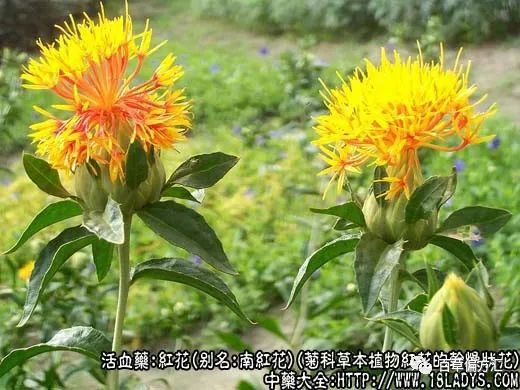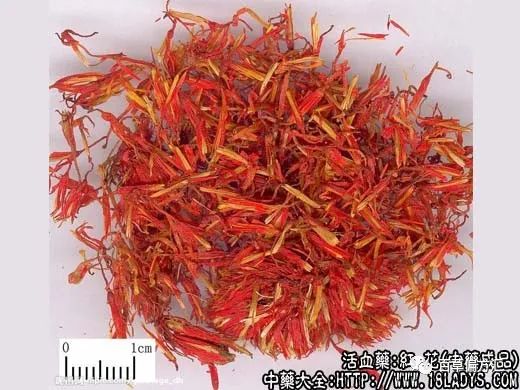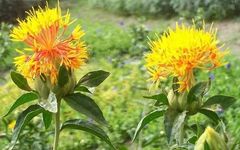


Safflower (红花, hóng huā) is a commonly used Chinese medicinal herb. It is referred to as “red and blue flower” in the Han Book and is explained as safflower in the “Kaibao Materia Medica”.
Other names: South safflower, grass safflower, red-blue flower, safflower hair.
Source: The dried flower of the annual or biennial herbaceous plant safflower (Carthamus tinctorius) from the Asteraceae family, mostly cultivated.
Plant morphology: The stem is cylindrical with fine shallow grooves, reaching heights of 30 to 90 cm, with the base becoming woody and the upper part branching extensively. The leaves are alternate, nearly sessile and slightly clasping the stem, ovate or ovate-lanceolate, slightly thick, with a sharp apex and serrated or spiny margins. The capitulum is terminal, with the involucre being ovate or hemispherical, and the bracts arranged in multiple whorls, with the outer 2 to 3 rows leaf-like and spiny, while the inner rows are membranous without spines. The flowers are tubular, with the upper part being reddish-yellow and the base gradually narrowing to yellow, clustered on the receptacle, with 5 stamens and 1 pistil, the stigma bifid and also yellow. The achene is ovate, white, with 4 prominent rib lines and no pappus.
Production area: Mainly produced in Henan, now cultivated in various regions across the country, with large-scale planting in Xinjiang.
Identification: The flowers are wrinkled, bent, and scattered in clusters or dispersed, reddish-yellow, and fine like hair, hence the local name safflower hair. A single flower is about 2 cm long, with a linear yellow or orange base, and the upper flower crown is tubular, about 0.8 cm long and 1.5 mm in diameter, with 5 lobes at the tip, red or orange, with yellow stamens and stigma, slightly fragrant, and with a mildly sweet and bitter taste. The best quality has a long flower crown and bright red color.
Main components: Contains safflower glycoside, also known as red pigment; also contains safflower yellow pigment.
Efficacy and functions: Breaking blood stasis, activating blood circulation, and regulating menstruation. According to preliminary animal experiments, its effects include:
1. Uterine stimulation: Its decoction and tincture can cause tonic or rhythmic contractions of the uterus, more pronounced in a pregnant uterus, with rapid and lasting effects.
2. Blood pressure reduction: It has a blood pressure-lowering effect and can maintain it for a longer duration.
3. Vasodilation: Safflower infusion has a certain effect on dilating coronary arteries.
Preparation: Used raw.
Taste and properties: Pungent, warm.
Meridians entered: Heart, liver.
Functions: Breaking blood stasis, activating blood circulation, regulating menstruation.
Indications: Irregular menstruation, postpartum abdominal pain, masses, traumatic blood stasis pain, carbuncles, and swelling pain.
Clinical applications: 1. Treating blood stasis menstrual pain and amenorrhea, utilizing its stimulating effect on the uterus to activate blood circulation and regulate menstruation. The indications and usage are similar to that of peach kernel (桃仁, táo rén). For postpartum lochia retention, blood stasis, and lower abdominal distension and pain, safflower can also be used, often combined with Angelica (当归, dāng guī), Achyranthes (牛膝, niú xī), and cinnamon (肉桂, ròu guì), as in the formula Zhe Chong Decoction (折冲汤).
2. Treating coronary heart disease and angina. Ancients recognized that safflower combined with Chuanxiong (川芎, chuān xiōng) and Angelica could treat “chest and abdominal blood stasis pain”. Modern practice uses 15g of safflower combined with 15g of Chuanxiong, decocted in water, once daily (or in tablet form), as a basic formula for treating angina due to qi stagnation and blood stasis, with certain efficacy, possibly related to the vasodilatory effects of Chuanxiong and safflower on coronary arteries. Reports indicate a relatively high recent efficacy rate for treating angina, but the overall efficacy remains unsatisfactory. Ginkgo leaves can also be added to create Yinchuan Hong Shuxue tablets, which are also effective for angina.
3. Treating traumatic injuries, with efficacy stronger than peach kernel. For contusions and sprains with subcutaneous bruising and swelling pain, safflower oil or safflower wine (prepared by soaking safflower in alcohol or decocting with rice wine) can be applied externally; for internal injuries with blood stasis, it can be combined with Sumu (苏木, sū mù), Angelica, and red peony (赤芍, chì sháo) to help alleviate pain, as in the formula for treating traumatic blood stasis (跌打活血汤).
4. Used for nourishing qi and blood, the dosage should be small, and a small amount of safflower can be added to warming tonics. For postpartum blood collapse, dizziness, blurred vision, cold qi, or even lockjaw (jaw tightly closed and difficult to open), it is advisable to use Eight Treasure Decoction (八珍汤) or roasted licorice decoction (炙甘草汤), adding 0.9 to 1.5g of safflower for better effects.
5. Safflower is used in ophthalmology, mainly for clearing heat and reducing inflammation, combined with Rehmannia (生地, shēng dì), red peony, and Forsythia (连翘, lián qiáo) to treat red and swollen eyes (including acute conjunctivitis, styes, etc.), as in the formula Safflower Powder (红花散).
Usage precautions: 1. Pregnant women should avoid use, as it can stimulate uterine contractions; those with excessive menstruation or bleeding tendencies should not use it; 2. Large amounts of safflower promote blood circulation and break blood stasis, while small amounts nourish blood and harmonize blood; 3. Both safflower and peach kernel can dispel stasis, but peach kernel is more widely used in blood conditions. For heat syndrome with blood stasis, peach kernel is more commonly used; for heart and abdominal stasis pain, safflower is more effective.
Dosage: Generally, 3 to 9g, slightly larger doses of 12 to 15g, and for harmonizing and nourishing blood, 0.9 to 15g.
Example prescriptions: 1. Zhe Chong Decoction: 9g safflower, 9g peach kernel (crushed), 9g red peony, 9g Angelica tail, 4.5g cinnamon (crushed), 4.5g Chuanxiong, 6g moutan root, 6g Yanhusuo, decocted with equal parts of wine and water.
2. Coronary Heart Tablets (Beijing Coronary Heart Disease Prevention and Treatment Cooperative Group): (Each 12 tablets contain 15g of Chuanxiong and safflower), taken three times daily, 4 tablets each time, with warm water.
3. Traumatic Blood Circulation Decoction: 6g safflower, 6g peach kernel (crushed), 6g Sumu, 9g Angelica tail, 9g red peony, 6g bitter orange peel, 1.5g costus, 9.5g frankincense, 4.5g myrrh, decocted in water.
4. Safflower Powder: 4.5g safflower, 6g Forsythia, 4g Angelica, 9g Rehmannia, 6g purple root, 9g red peony, 4.5g rhubarb, 3g licorice, decocted in water.
Note: Safflower leaves and bracts can have spiny or non-spiny varieties.

